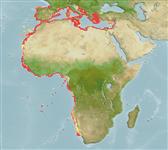Common names from other countries
Environment: milieu / climate zone / depth range / distribution range
экология
; солоноватоводный; пределы глубины 76 - 496 m (Ref. 1695). Subtropical; 45°N - 30°S, 18°W - 36°E (Ref. 107067)
Eastern Atlantic and the Mediterranean: from Spain to Namibia.
Length at first maturity / Size / Вес / Возраст
Maturity: Lm ? range ? - ? cm Max length : 2.5 cm ML самец/пол неопределен; (Ref. 104052)
Inhabits muddy bottoms; a sublittoral, demersal, or upper bathyal species found in depths between 76 and 496 m. Found in the brackish waters of the Sea of Marmara (salinity between 18 and 25 ppt). Species in the eastern and western Mediterranean (Aegean Sea) likely have an extended spawning period since mature animals are found throughout the year. May ascend to the surface during the spawning period and has been collected at the surface at night using artificial light. Caught throughout its range and consumed locally (Ref. 1695). Feeds mainly on crustaceans and fish (Ref. 107001).
Life cycle and mating behavior
половая зрелость | размножение | нерест | икра | Fecundity | личинки
Members of the class Cephalopoda are gonochoric. Male and female adults usually die shortly after spawning and brooding, respectively. Mating behavior: Males perform various displays to attract potential females for copulation. During copulation, male grasp the female and inserts the hectocotylus into the female's mantle cavity where fertilization usually occurs. Life cycle: Embryos hatch into planktonic stage and live for some time before they grow larger and take up a benthic existence as adults.
Основная ссылка
ссылки | координатор | соавторы
Jereb, P. and C.F.E. Roper (eds.). 2005. (Ref. 1695)
Статус Красного Списка МСОП (Ref. 130435)
Статус СИТЕС (Ref. 108899)
Not Evaluated
Not Evaluated
Использование человеком
| FishSource |
инструменты
дополнительная информация
Возраст/РазмерыростЗависимость между длиной и массой телаЗависимость между длинамиморфологияличинкичисленность
ресурсы в Интернет
Estimates based on models
Preferred temperature
(Ref.
115969): 10.9 - 15.8, mean 14.1 (based on 159 cells).
Уязвимость
Low vulnerability (10 of 100).
Категория цены
Unknown.
